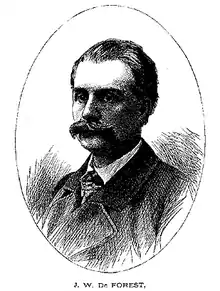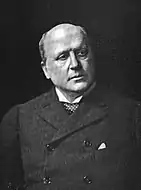Great American Novel
The Great American Novel (GAN) is a canonical novel that is thought to embody the essence of America, generally written by an American and dealing in some way with the question of America's national character. The Great American Novel is considered America's equivalent of the national epic. The term was coined by John William De Forest in an 1868 essay. Although De Forest mentioned Uncle Tom's Cabin (1852) as a possible contender, he noted that the Great American Novel had most likely not been written yet. Writer Henry James shortened the term to GAN in 1880. Since then the concept has evolved and been much maligned, by critics and writers alike.

In modern usage, the meaning of the term is often figurative and represents a canonical piece of literature, making it a literary benchmark emblematic of what defines U.S. literature in a given era. Practically, many academics use the term to refer to a small number of books that have historically been the nexus of discussion, including Moby-Dick (1851), Adventures of Huckleberry Finn (1884), and The Great Gatsby (1925). However, there is no consensus on which novel, or novels, merits the title of Great American Novel.
Academics and writers have noted that many possible GANs were written by immigrants to America. Most were also written by men. GAN candidates span a wide variety of genres and setting. Others have noted that they are often expansive narratives, similar to epics.
History
Background and etymology
While literary fiction was written and published in British America as early as the 17th century, it was not until a distinct United States identity developed in the 18th century that works considered American literature first appeared. The U.S. identity as a nation was reflected alongside the development of its literature.[1] By the mid-century, the idea of American literature exceeding it's European counterparts began to take shape.[2] According to Grant Shreve of JSTOR Daily, "[t]he dream of a unifying national book had been around since the earliest days of the Republic, but the Great American Novel didn’t fully gel as a concept until the end of the Civil War".[3] Lawrence Buell saw the 1840s as the start of novels being written that would later be considered the Great American Novel.[4]
The term Great American Novel originated in an 1868 essay by American Civil War novelist John William De Forest.[5] De Forest saw it serving as a "tableau" of American society; Daniel Pierce Thompson said it had to be distinctly American.[5][6] De Forest criticized James Fenimore Cooper's The Last of the Mohicans (1826) and noted that it did not deserve to be called the Great American Novel. He expressed his admiration for the works of Washington Irving and Nathaniel Hawthorne, but also claimed that they were not fit to be given the title.[7] He ultimately concluded that the Great American Novel had yet to be written.[3] In 1880, writer Henry James simplified the term with the initialism "GAN".[8]
Development
The term soon became popular: its ubiquity considered a cliché and disparaged by literary critics.[9] Buell, stated that the concept was seen as a part of a larger national, cultural and political consolidation.[5] According to Shreve, as the concept grew, criteria for the GAN arose:
- "It must encompass the entire nation and not be too consumed with a particular region.
- It must be democratic in spirit and form.
- Its author must have been born in the United States or have adopted the country as his or her own.
- Its true cultural worth must not be recognized upon its publication".[3]
George Knox's 1969 entry in American Quarterly claimed that by the turn of the century many critics were reluctant to invoke the idea of the GAN, due to possible ridicule.[10] This continued into the middle-twentieth century, when academies began to dismiss the GAN as a "naively amateurish age-of-realism pipe dream".[5] Bernard F. Rogers noted in 1974 that "The "GAN" really belongs to the nineteenth century, not the twentieth".[2]
Writers such as William Dean Howells and Mark Twain were equally blasé. Frank Norris proclaimed in 1901 that "The GAN is either as extinct as the Dodo or as far in the future as the practical aeroplane..the thing to be looked for is not the Great American Novelist, but the Great Novelist who shall also be an American".[10] Edith Wharton complained, in 1927, that the GAN concept held a narrow view and was "always about Main Street, geographically, socially, and intellectually". She also felt that claims of the GAN were made too often; once ironically inventing the Great American-Novel-of-the-Month.[10] At this time, it also grew to become associated with masculine values.[11]
Despite this critical disregard, many writers, according to Maxine Hong Kingston, wanted to create the next GAN; Upton Sinclair and Sinclair Lewis both sought to create the GAN with The Jungle (1906) and Babbit (1924), respectively.[12] “Templates” and “recipes” for the GAN were created in the hopes of helping writers.[3] In 1938, Clyde Brion Davis released The Great American Novel, an ironic, fictional, exploration of the concept.[10] Rogers said that Kurt Vonnegut's "entire career might be characterised as an attempt to produce something like "the GAN", but of its own time".[2]
A similar satirical novel, to Davis', about the concept was released by Philip Roth, also called The Great American Novel, in 1973.[13] The 1970s saw a general ressurgence in the concept, with the New York Times using the phrase the most in their history, a total of 71 times.[14][lower-alpha 1] Tom Perrin, in the 2018 book American Literature in Transition, 1970–1980, speculated that this revival was due to the "decade's considerable anxieties". The concept was again aligned with masculinity and according to Perrin sought to "neturalize the tension" between it, "individualism" and "the social upheavals that challanged them".[14]
In the 21st century, the concept has taken on a new more expanded form; moving past, primarily, the concern of scholars and towards a more populist attitude.[15][lower-alpha 2] Shreve called it "catnip for a listicle-obsessed internet"; it's relevance and achievability is frequently debated.[3][17] Adam Kirsch claimed in 2013 that "Hardly anyone talks about the Great American Novel without a tincture of irony these days". Although, Kirsch conceded that books such as Jonathan Franzen’s Freedom (2010), Roth’s American Pastoral (1997), and Don DeLillo’s Underworld (1997) indicate that writers are still intrested in creating the GAN.[18] Commenting upon the GAN's place in the 21st century, Stephens Shapiro said that:
Maybe the GAN is a theme that rises in interest when the existing world system is amidst transformation, as America's greatness of all kinds swiftly fades away.[4]
When asked in a 2004 interview if the GAN could be written, Norman Mailer—who had long been intrested in the idea[19]—said it could not, for America had became too developed of an nation.[20] Tony Tulathimutte similarly dismissed it as "a comforting romantic myth, which wrongly assumes that commonality is more significant than individuality".[21]
Analysis
Racial and gender commentary
According to British writer Martin Amis, immigrants or "non-Americans" were critical in the evolution of the GAN. He pointed to the fact that many GAN authors were foreign-born or of an immigrant background, such as Vladimir Nabokov. According to Lucy Scholes, in an article for BBC Culture, the evolution of the GAN was largely influenced by "the various waves of immigration that have lapped at America’s shore".[17][22]
Annika Barranti Klein said in a Book Riot article that "The glaring issue with De Forest’s concept is its unbearable whiteness".[23] Rigoberto González noted that "The GAN considers the big lives of those people American literature has marginalized".[24] Kirsch claimed that GAN candidates often tried to "bridge the racial divide".[18] Commenting upon the idea's racial aspects and presence in popular conscious, Hugh Kenner wrote in a 1953 issue of Perspective that:
The lad who was going to produce 'The Great American Novel' as soon as he had gotten his mind around his adolescent experience is part of the folklore of the 'twenties, and the prevalence of this myth documents the awareness of the young American of thirty years ago that the consciousness of his race remained uncreated.[10]
Perrin, Andrew Hoberek and Barbara Probst Solomon all noted that the 70s saw Jews become involved with the idea. Perrin said it was a boom decade for, what Hoberek, called the "Jewish GAN". Solomon was by 1972 sick of "nice Jewish sons who are writing the GAN". Aaron Latham, in a 1971 article, highlighted Roth and Mailer as Jews who wanted to the write the next GJN and GAN, respectively.[14]
The GAN's relation to masculinity was seen as a problem by female writers. Gertrude Stein once lamented that, as a gay Jewish woman, she would be unable to compose the GAN. Joyce Carol Oates similarly felt that "a woman could write it, but then it wouldn't be the GAN".[11] Ursula K. Le Guin, felt that "[i]t makes perfect sense to me that I've never heard a woman writer say she intended, or wanted, to write the GAN".[25] Viet Thanh Nguyen said that "[o]ne of the unspoken silences of the Great American Novel is the assumption that it can only be written by white men".[26] Laura Miller wrote, in a Salon article, that "The presumption and the belligerence embodied in this ideal have put off many American women writers". She also noted that many characters in GAN candidates are male: "the notion that a female figure might serve the same purpose undermines the very concept of the Great American Novel".[19] Emily Temple of Literary Hub suggested that if the protagonist of Sylvia Plath's The Bell Jar (1963) were male it would likely be considered more seriously as a GAN contender.[27]
Interpretations
There are several different interpretations of what makes a GAN. Some say that it depicts a diverse group facing issues representative of "epoch-defining public events or crises."[8] John Scalzi felt that for a novel to be the GAN it had to be ubiquitous, notable and analyze America through a moral context.[28] De Forest, similarly saw the GAN as having to capture the "essence" of America, its quality irrelevant.[29]
Writer A.M. Homes said that the specific usage of great should not be a statement of quality, but rather, one of expanse; within this context, she felt that she had written a GAN with May We Be Forgiven (2012).[11] Norris shared similar sentiments, saying that "[i]t" all depends upon what you mean by Great, what you mean by American". He thought the musings on what did or did not qualify as "Great" or as "American" showcased patriotic insecurity.[10] Mohsin Hamid wrote that "[t]he problem is in the phrase itself. 'Great' and 'Novel' are fine enough. But 'the' is needlessly exclusionary, and 'American' is unfortunately parochial. The whole, capitalized, seems to speak to a deep and abiding insecurity, perhaps a colonial legacy."[30]
Commentators have said that the concept is exclusively American in nature.[29] Journalist John Walsh offered a national equal in the form of Russian writer Leo Tolstoy's War and Peace (1869); Buell felt that Australia was the only contury to replicate America's search.[17][4][lower-alpha 3] Scholes said that the GAN has always been thought of adjacent to European literature.[17] David Vann was of the belief that they had to be "anti-American".[31] Rogers felt that it doesn't need to have American protagonists or be set in America and shouldn't espouse patriotism or nationalism.[2]
Buell identifies multiple types of GANs. First is one who is subject to mysticism and stands the test of time.[32] The second is "the romance of the divide", which imagine nationals rifts in the "form of a family history and/or heterosexual love affair"—race often plays a role.[3][32] Thirdly, one that encapsulates the American Dream and see its protagonist rise from obscurity.[14] Fourthly, novels which are composed of a diverse cast of characters "imagined as social microcosms or vanguards" and who are placed with events and crises that serve to "constitute an image of 'democratic' promise or dysfunction". Buell also said Speculative science fiction may be the basis for a possible fifth archetype.[4]
Kasia Boddy wrote that, "[s]ince its initial formulation", the concept "has always been more about inspiration than achievement; the very fact that it has been attempted but remains 'unwritten' providing a spur to future engagement with both nation and national literature".[11] Speculating on De Forest's intentions when devising the GAN idea and commenting upon its development, Cheryl Strayed wrote that:
De Forest was arguing in hopes of not one Great American Novel, but rather the development of a literary canon that accurately portrayed our complex national character, has been lost on many, as generation after generation of critics have since engaged in discussions of who might have written the Great American Novel of any given age, and writers have aspired to be the one chosen — a competitive mode that is, I suppose, as American as it gets. It’s also most likely the reason that the idea has persisted for so long. To think that one might be writing the Great American Novel, as opposed to laboring through a meandering 400-page manuscript...is awfully reassuring. I have a purpose! I am writing the Great American Novel![13]
Regarding this lack of consensus, critic A. O. Scott compared it to the Yeti, the Loch Ness monster and the Sasquatch, in that many people—some boasting "impressive documentation"—have "[claimed] to have seen it".[33]
Equivalents in other media
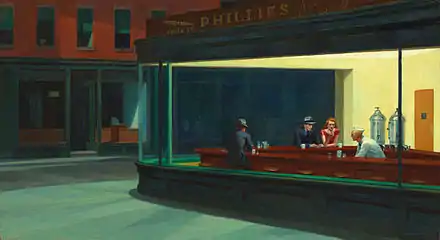
Equivalents to the GAN in other media have been proposed. For example:
- "The Great American Painting"[34]
- American Gothic (1930) ― Grant Wood
- Cow's Skull: Red, White, and Blue (1930) ― Georgia O'Keefe[lower-alpha 4]
- Nighthawks (1942) ― Edward Hopper
- Blinding Light (1947–48) ― Corinne Michelle West
- "The Great American TV Show"
- The Sopranos (1999–2007) ― David Chase[36]
- "The Great American Movie"[37]
- Gone with the Wind (1939) ― Victor Fleming
- "The Great American Poem"[38]
- The Gettysburg Address (1863) ― Abraham Lincoln
De Forest claimed that "the Great American Poem" could only be created after the United States had experienced hundreds of years of democracy; however, he believed that the GAN could be written much sooner.[8] Mark Binelli of the New York Times called documentary filmmaker Frederick Wiseman the "Great American Novelist" and said that his 50-year filmography was a manifestation of the GAN.[39] Jess Zafariss suggested that the Marvel Comics by Jack Kirby and Stan Lee deserve the title.[7]
Notable candidates
| Year | Cover or title page |
Novel | Portrait | Author | Commentary | Ref. |
|---|---|---|---|---|---|---|
| 1826 | 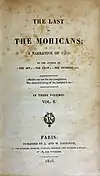 |
The Last of the Mohicans |  |
James Fenimore Cooper | Although De Forest critiqued Cooper's writing as boring, many consider The Last of the Mohicans to be the first GAN. It was influential in defining American literature and addresses themes which are common in later American works, including rugged individualism and freedom. | [40][41] |
| 1850 | 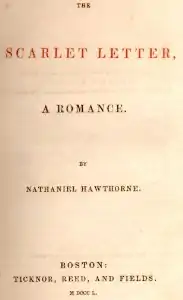 |
The Scarlet Letter | 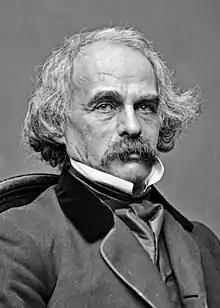 |
Nathaniel Hawthorne | Although De Forest specifically labelled The Scarlet Letter as not being worthy of the label of GAN, it is now widely included on most lists.[42] Buell recognized it as a "reluctant master text"—his first GAN script.[43] | [44][45] |
| 1851 | 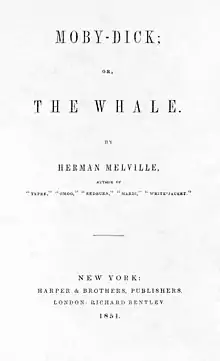 |
Moby-Dick |  |
Herman Melville | According to Hester Blum of Penn State University, "What makes Moby-Dick the Greatest American Novel, in other words, is that Melville can invoke the preposterous image of a sobbing, heart-stricken moose and we think, yes, I have come to know exactly what that sounds like, and I know what world of meaning is contained within that terrific sound".[22] | [5][18] |
| 1852 |  |
Uncle Tom's Cabin | 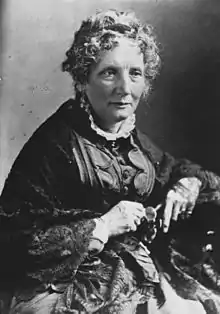 |
Harriet Beecher Stowe | Buell, claimed it to be the first novel to receive the acclaim of the GAN and that it was widely accepted that it was 'nearest approach to the desired phenomenon'.[11][46] De Forest noted it as the only possible contender and as "a picture of American life".[7] | [47] |
| 1884 |  |
Adventures of Huckleberry Finn |  |
Mark Twain | The Adventures of Huckleberry Finn was one of the first American novels to utilize a regional vernacular.[48] In 1935, Ernest Hemingway stated that "All modern American literature comes from one book by Mark Twain called 'Huckleberry Finn'."[49] William van O'Connor wrote, in a 1955 issue of College English, that "we are informed, from a variety of critical positions, that [it] is the truly American novel".[50] | [51][52][22] |
| 1895 |  |
The Red Badge of Courage | 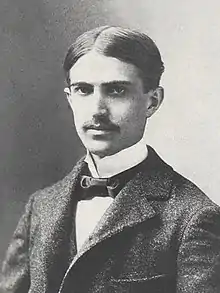 |
Stephen Crane | Crane was among the earliest generation of American novelists to be influenced by De Forest and consciously strove to produce a "National Novel".[53] Critic Robert Barr had named him the "most likely to produce the great American novel" only two years before Crane died suddenly at the age of 28.[54] According to Yale professor of literature Jay Martin, Crane's war novel The Red Badge of Courage, set during the Civil War, "marks the culmination of the Great American Novel".[55] | [55] |
| 1925 | .jpg.webp) |
The Great Gatsby | 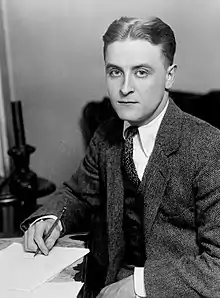 |
F. Scott Fitzgerald | Emory Elliott, wrote, in 1991, that it is "still frequently nominated as the GAN".[56] Kirsch, in 2013, said it to be "one of the first titles to come to mind whenever the Great American Novel is mentioned".[18] Deirdre Donahue of USA Today and Fitzgerald scholar James L. W. West III felt that its "embodiment of the American spirit", relevance and prose were the reasons as to why it's the GAN.[57] | [58][59][60] |
| 1936 | .jpg.webp) |
Absalom, Absalom! |  |
William Faulkner | Absalom, Absalom! has been said to represent Buell's "romance of the divide".[18] | [61][18] |
| 1939 | .jpg.webp) |
The Grapes of Wrath |  |
John Steinbeck | Jay Parini identified it as "a great American novel" due to its focus on America during a crisis and the electic depiction of American life. Richard Rodriguez, similarly, felt that it was "the great American novel that everyone keeps waiting for" because of how it showed the "the losers in America".[62] | [62][63] |
| 1943 | _-_Ayn_Rand.jpg.webp) |
The Fountainhead | .jpg.webp) |
Ayn Rand | Evan Carton, building on a definition by Buell, called The Fountainhead a book elevated to GAN status by readers and not critics.[64] | [65][64] |
| 1951 | .jpg.webp) |
The Catcher in the Rye | .jpg.webp) |
J. D. Salinger | The Catcher in the Rye is an example of a writer setting out to write the GAN and receiving such praise.[66] | [67][66] |
| 1952 | .jpg.webp) |
Invisible Man | 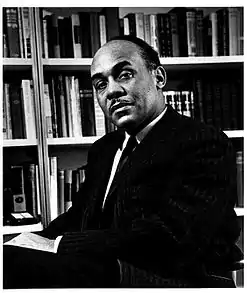 |
Ralph Ellison | Joseph Fruscione said that the Invisible Man was the GAN because it can be "many things to many readers".[22] | [68][69] |
| 1953 |  |
The Adventures of Augie March | 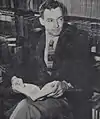 |
Saul Bellow | Amis felt that The Adventures of Augie March was the GAN because of its "fantastic inclusiveness, its pluralism, its qualmless promiscuity".[27] | [17][70] |
| 1955 |  |
Lolita | 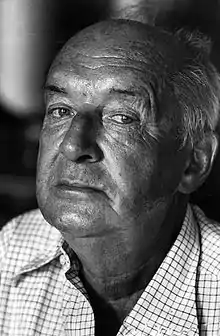 |
Vladimir Nabokov | Mary Elizabeth Williams called Lolita the GAN because of its prose.[22] | [71][22] |
| 1960 | .jpg.webp) |
To Kill a Mockingbird | .jpg.webp) |
Harper Lee | Scalzi calls it a GAN in that it is a notable and ubiquitous work that also deals with morality and the American experience.[28] Oprah Winfrey described it as "our national novel."[72] | [73][28] |
| 1973 | .jpg.webp) |
Gravity's Rainbow | 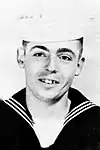 |
Thomas Pynchon | Pynchon's postmodern novel of World War II is commonly cited as "the most important American novel" of the post-war era.[74] It has been said to conform to Buell's fourth type of GAN.[14] | [75][76][77] |
| 1985 | .jpg.webp) |
Blood Meridian | .jpg.webp) |
Cormac McCarthy | Vann felt that Blood Meridian was a GAN because it explored America's genocidal past.[22] | [78][31] |
| 1987 | .jpg.webp) |
Beloved | .jpg.webp) |
Toni Morrison | The novel is noted for its depiction of the psychological effects of slavery and racism. When Beloved topped a poll of "the single best work of American fiction" published from 1980–2005, A. O. Scott remarked that "Any other outcome would have been startling, since Morrison's novel has inserted itself into the American canon more completely than any of its potential rivals."[33] Beloved has been noted to align with Buell's third type of GAN.[14] | [33][79] |
| 1991 | 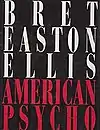 |
American Psycho |  |
Bret Easton Ellis | Julia Keller saw the novel's inclusion of "brand names and sex and social anxiety" as part of the reason why it is the GAN.[80] | [80][81] |
| 1996 |  |
Infinite Jest | .jpg.webp) |
David Foster Wallace | Buell noted that "For an appreciable number of turn-of-the-twenty-first-century readers...Infinite Jest [is] the GAN of our days".[82] | [82][27] |
| 1997 |  |
Underworld | 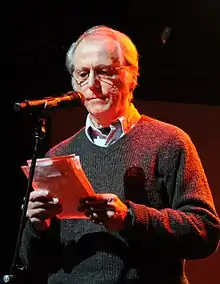 |
Don Delillo | According to Robert McCrum, it developed a reputation as the GAN almost immediately after its publication.[83] | [17][83][84] |
| 2010 | .jpg.webp) |
Freedom | 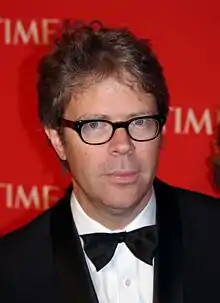 |
Jonathan Franzen | Buell described it as the "most widely acclaimed GAN contender...post-9/11".[12] | [85][17] |
| 2012 | 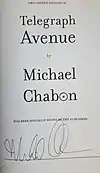 |
Telegraph Avenue |  |
Michael Chabon | John Freeman of the Boston Globe, praised Chabon for "imagining the Great American Novel with a multiracial cast."[86] | [87][88] |
See also
References
- Baym, Nina, ed. The Norton Anthology of American Literature. New York: W.W. Norton & Company, 2007. Print.
- Jr, Bernard F. Rodgers (December 1, 1974). "The Great American Novel and "The Great American Joke"". Critique: Studies in Contemporary Fiction. 16 (2): 12–29. doi:10.1080/00111619.1974.10690080. ISSN 0011-1619.
- Shreve, Grant (December 17, 2017). "The Great American Game of Picking the Great American Novel". JSTOR Daily. JSTOR. Retrieved January 21, 2021.
- Shapiro, Stephen (2015). "Review: The Dream of the Great American Novel". Nineteenth-Century Literature. 69 (4): 539–543. doi:10.1525/ncl.2015.69.4.539. ISSN 0891-9356. JSTOR 10.1525/ncl.2015.69.4.539.
- Buell, Lawrence (2008). "The Unkillable Dream of the Great American Novel: Moby-Dick as Test Case". American Literary History. 20 (1–2): 132–155. doi:10.1093/alh/ajn005. S2CID 170250346. Archived from the original on January 8, 2016. Retrieved October 26, 2010.
- Brown, Herbert R. (1935). "The Great American Novel". American Literature. 7 (1): 1–14. doi:10.2307/2920328. ISSN 0002-9831. JSTOR 2920328. Archived from the original on January 14, 2021. Retrieved January 4, 2021.
- Zafarris, Jess (July 4, 2018). "The First Book to Ever Be Dubbed the "Great American Novel" Might Not Be the One You'd Guess". Writer's Digest. Archived from the original on August 1, 2020. Retrieved June 15, 2020.
- Showalter, Elaine (February 20, 2014). "Can the Great American Novel survive?". Prospect. Retrieved June 15, 2020.
- Buell, Lawrence (2014). The Dream of the Great American Novel. Cambridge, Massachusetts: Harvard University Press. ISBN 978-0-674-05115-7. OCLC 871257583.
- Knox, George (1969). "The Great American Novel: Final Chapter". American Quarterly. 21 (4): 667–682. doi:10.2307/2711602. ISSN 0003-0678. JSTOR 2711602. Archived from the original on January 18, 2021. Retrieved January 16, 2021.
- Boddy, Kasia (February 7, 2019). "Making it long: men, women, and the great American novel now". Textual Practice. 33 (2): 318–337. doi:10.1080/0950236X.2018.1509268. ISSN 0950-236X. S2CID 150330138. Archived from the original on January 18, 2021. Retrieved January 15, 2021.
- Buell 2014, p. 3-4.
- Strayed, Cheryl; Kirsch, Adam (January 13, 2015). "Why Are We Obsessed With the Great American Novel?". The New York Times. Retrieved January 19, 2020.
- Perrin, Tom (February 2018). "Chapter 12 - The Great American Novel in the 1970s". In Curnutt, Kirk (ed.). American Literature in Transition, 1970–1980. American Literature in Transition. Cambridge: Cambridge University Press. ISBN 978-1-107-15076-8.
- Buell 2014, p. 5,9.
- Buell 2014, p. 387.
- Scholes, Lucy (October 21, 2014). "Can a 'Great American Novel' be written in French?". BBC. Retrieved January 22, 2021.
- Kirsch, Adam (January–February 2014). "Made in the U.S.A." Harvard Magazine. Archived from the original on November 11, 2020. Retrieved December 23, 2020.
- Miller, Laura (June 6, 2013). "Rachel Kushner's ambitious new novel scares male critics". Salon. Archived from the original on January 14, 2021. Retrieved January 17, 2021.
- Hammond, Margo (February 5, 2004). "Norman Mailer on the Media and the Message". Poynter. Retrieved January 17, 2021.
- Tulathimutte, Tony (December 7, 2016). "Why There's No 'Millennial' Novel (Published 2016)". The New York Times. ISSN 0362-4331. Retrieved January 19, 2021.
- Harrnett, Kevin (July 10, 2013). "The Greatest American Novel? 9 Experts Share Their Opinions". The Millions. Archived from the original on December 8, 2020. Retrieved January 17, 2021.
- Klein, Annika Barranti (April 13, 2020). "What is the Great American Novel?". Book Riot. Retrieved January 19, 2021.
- González, Rigoberto (June 30, 2016). "Rigoberto Gonzalez's Great Américas Novel: 'The Brief Wondrous Life of Oscar Wao' by Junot Díaz". Los Angeles Times. Archived from the original on November 8, 2020. Retrieved January 17, 2021.
- Le Guin, Ursula K. (December 2017). No Time to Spare: Thinking About What Matters. Houghton Mifflin Harcourt. ISBN 9781328661593.
- Nguyen, Viet Thanh (June 30, 2016). "Viet Thanh Nguyen's Great American Novels: 'The Woman Warrior' and 'China Men'". Los Angeles Times. Retrieved January 19, 2021.
- Temple, Emily (January 9, 2017). "A Brief Survey of the Great American Novel(s)". Literary Hub. Archived from the original on January 14, 2021. Retrieved January 17, 2021.
- Scalzi, John (June 30, 2016). "The Great American Novel is 'To Kill a Mockingbird'". The Los Angeles Times. Los Angeles. Archived from the original on July 14, 2020. Retrieved May 14, 2020.
- Konnikova, Maria (June 30, 2012). "Why Are Americans Obsessed With the Great American Novel?". Slate. Retrieved January 22, 2021.
- Hamid, Mohsin (October 15, 2013). "Where Is the Great American Novel by a Woman?". The New York Times. ISSN 0362-4331. Retrieved January 21, 2021.
- Vann, David (November 14, 2009). "David Vann on Cormac McCarthy's Blood Meridian | Rereading". The Guardian. ISSN 0261-3077. Archived from the original on July 13, 2020. Retrieved January 17, 2021.
- Baym, Nina (2014). "Review of The Dream of the Great American Novel". The New England Quarterly. 87 (3): 538–540. doi:10.1162/TNEQ_r_00397. ISSN 0028-4866. JSTOR 43285103. S2CID 147646001.
- Scott, A. O. (May 21, 2006). "In Search of the Best". The New York Times. Archived from the original on July 9, 2020. Retrieved July 2, 2020.
- Grovier, Kelly (October 5, 2020). "Blinding Light: The 'Great American Painting'?". BBC Online. Retrieved January 21, 2021.
- Griffin, Randall (October 7, 2014). "In praise of ... Georgia O'Keeffe's patriotic palette | art | Phaidon". Phaidon. Retrieved January 21, 2021.
- Dhruv, Swapnil (January 10, 2021). "The monumental legacy of 'The Sopranos'". Far Out Magazine. Retrieved January 21, 2021.
- Haskell, Molly (February 19, 2020). "Gone With the Wind: The Great American Movie". Life. Retrieved January 21, 2021.
- McPherson, James M. (September 24, 2009). "Lincoln Off His Pedestal". The New York Review of Books. ISSN 0028-7504. Retrieved January 22, 2021.
- Binelli, Mark (December 15, 2020). "What if the Great American Novelist Doesn't Write Novels?". The New York Times. ISSN 0362-4331. Retrieved January 21, 2021.
- Italie, Hillel. "'Last of the Mohicans' was first great American novel". Retrieved October 14, 2015.
- Lewis, Randy (October 3, 1992). "Writer's Wit Found Target in 'Mohicans'". The Los Angeles Times. Archived from the original on August 1, 2020. Retrieved August 20, 2020.
- Konnikova, Maria (June 29, 2012). "The Great American Novel". Slate. Archived from the original on January 14, 2021. Retrieved June 15, 2020.
- Baym, Nina (2014). "Review of The Dream of the Great American Novel". The New England Quarterly. 87 (3): 538–540. doi:10.1162/TNEQ_r_00397. ISSN 0028-4866. JSTOR 43285103. S2CID 147646001.
- Messent, Peter. "The Dream of the Great American Novel, by Lawrence Buell". Times Higher Education. Archived from the original on January 8, 2016. Retrieved October 14, 2015.
There are, Buell says, four main types of potential Great American Novels. Nathaniel Hawthorne's The Scarlet Letter epitomises the first – a cultural 'master narrative', identified as such by the number of reinterpretations and imitations that follow in its wake.
- Latson, Jennifer (March 16, 2015). "Why The Scarlet Letter Was a Mixed Blessing for Its Author". Time. Archived from the original on August 21, 2020. Retrieved May 17, 2020.
- Buell 2014, p. 4.
- Fuller, Randall (May 2013). "The First Great American Novel". National Endowment for the Humanities. Archived from the original on August 1, 2020. Retrieved May 15, 2020.
- Smith, Henry Nash (1984). "The Publication of "Huckleberry Finn": A Centennial Retrospect". Bulletin of the American Academy of Arts and Sciences. 37 (5): 18–40. doi:10.2307/3823856. JSTOR 3823856.
- Ulin, David L. (November 14, 2010). "Celebrating the genius of 'Huckleberry Finn'". Los Angeles Times. Los Angeles. Archived from the original on August 1, 2020. Retrieved May 14, 2020.
- O'Connor, William van (1955). "Why Huckleberry Finn Is Not the Great American Novel". College English. 17 (1): 6–10. doi:10.2307/495715. ISSN 0010-0994. JSTOR 495715. Archived from the original on January 18, 2021. Retrieved January 16, 2021.
- Brown, Robert B. (June–July 1984). "One Hundred Years of Huck Finn". American Heritage Publishing. Archived from the original on August 18, 2011. Retrieved December 10, 2011.
It was called the 'great American novel' as early as 1891 by the English writer Andrew Lang ...
- Mailer, Norman (December 9, 1985). "Huckleberry Finn, Alive at 100". The New York Times. Archived from the original on August 28, 2020. Retrieved May 15, 2020.
- Martin, Jay (1967). Harvests of Change: American Literature, 1865–1914. Englewood Cliffs, New Jersey: Prentice-Hall, Inc. p. 55. LCCN 67-14850 – via the Internet Archive (registration required).CS1 maint: ref=harv (link)
- Martin 1967, p. 56, fn. 68.
- Martin 1967, p. 35.
- Emory Elliott et al. (eds.) (1991). The Columbia History of the American Novel Archived January 7, 2014, at the Wayback Machine. Columbia University Press. p. 323. "The Great Gatsby (1925), a work still frequently nominated as 'the great American novel' ..."
- Donahue, Deirdre (May 7, 2013). "Five reasons 'Gatsby' is the great American novel". USA Today. Retrieved January 20, 2021.
- Achenbach, Joel (March 20, 2015). "Why 'The Great Gatsby' is the Great American Novel". The Washington Post. Archived from the original on June 15, 2020. Retrieved May 17, 2020.
- Williams, John (January 14, 2021). "The 'Great Gatsby' Glut". The New York Times. ISSN 0362-4331. Retrieved January 21, 2021.
- Gutterman, Annabel (December 24, 2020). "What 'The Great Gatsby' Copyright Expiration Means for Its Legacy". Time. Retrieved January 21, 2021.
- Hirsch, Arthur (November 16, 1997). "The real great American Novel: 'Absalom, Absalom!' Faulkner: His ninth novel, for its span, its revelation, its American essence, stands above all others in reaching for this literary absolute". The Baltimore Sun. Baltimore, Maryland. Archived from the original on December 29, 2011. Retrieved September 21, 2010.
- Gioia, Dana. "The Grapes of Wrath Radio Show (interview with Richard Rodriguez) – Transcript". The Big Read. The National Endowment for the Arts. Archived from the original on June 20, 2010. Retrieved September 22, 2010.
There hasn't been anything like this novel since it was written. And this is the great American novel that everyone keeps waiting for but it has been written now.
- Nixon, Rob. "The Grapes of Wrath". This Month Spotlight. Turner Classic Movies. Archived from the original on January 4, 2013. Retrieved September 22, 2010. Nixon quotes John Springer, author of The Fondas (Citadel, 1973), a book about Henry Fonda and his role in film version of The Grapes of Wrath: "The Great American Novel made one of the few enduring Great American Motion Pictures."
- Carton, Evan (April 22, 2015). "The Dream of the Great American Novel" (PDF). ALH Online Review. University of Texas. II: 5.
- Gladstein, Mimi Reisel (2000). "The Great American Novel". The Journal of Ayn Rand Studies. Penn State University Press. 2 (1): 117–130. ISSN 1526-1018. JSTOR 41560134.
- Burke, Declan (July 13, 2011). "Sixty years and 65m copies on: Holden Caulfield and the great American novel". The Irish Times. Archived from the original on August 10, 2020. Retrieved May 15, 2020.
- McGrath, Charles (January 28, 2010). "J. D. Salinger, Literary Recluse, Dies at 91". New York Times. Archived from the original on February 5, 2017. Retrieved February 24, 2017.
- Giles, Patrick (September 15, 2002). "The Great American Novel". Los Angeles Times. Archived from the original on December 29, 2011. Retrieved April 1, 2011.
- Gambaccini, Paul (October 7, 2015). "Book of a Lifetime by Paul Gambaccini - Invisible Man by Ralph Ellison". The Independent. Archived from the original on January 14, 2021. Retrieved December 23, 2020.
- Shteir, Rachel (May 7, 2019). "A New Adventure for 'Augie March': A Chicago Stage (Published 2019)". The New York Times. ISSN 0362-4331. Retrieved January 28, 2021.
- Williams, Mary Elizabeth (September 30, 1996). "Personal Best: Lolita". Salon. Archived from the original on November 12, 2020. Retrieved January 17, 2021.
- "'Mockingbird' Moments: 'Scout, Atticus And Boo'". NPR. July 8, 2010. Archived from the original on January 10, 2020. Retrieved January 18, 2021.
- Puente, Maria (July 8, 2010). "'To Kill a Mockingbird': Endearing, enduring at 50 years". USA Today. Archived from the original on October 17, 2011. Retrieved August 29, 2017.
It is Lee's only book and one of the handful that could earn the title of Great American Novel.
(Lee has since published a sequel, Go Set a Watchman.) - Buell 2014, pp. 426
- Buell 2014, pp. 426–427
- Weisenburger, Steven C. (2006). A Gravity's Rainbow Companion: Sources and Contexts for Pynchon's Novel. University of Georgia. pp. 1–2. ISBN 978-0-8203-2811-9.
- Deresiewicz, William (June 2014). "How the Novel Made the Modern World". The Atlantic. Archived from the original on July 2, 2020. Retrieved July 2, 2020.
- Dalrymple, William. "Blood Meridian is the Great American Novel". Reader's Digest. Archived from the original on July 28, 2020. Retrieved May 10, 2020.
McCarthy’s descriptive powers make him the best prose stylist working today, and this book the Great American Novel.
- Buell 2014, pp. 317–348
- Keller, Julia (July 1, 2007). "The Great American Novel was written by". The Chicago Tribune. Retrieved January 19, 2021.
- Burton, Charlie (June 5, 2019). "How the Great American Novel made it to the movies". GQ. Retrieved January 19, 2021.
- Buell 2014, p. 57.
- McCrum, Robert (August 3, 2015). "The 100 best novels: No 98 – Underworld by Don DeLillo (1997)". The Guardian. ISSN 0261-3077. Retrieved January 28, 2021.
- Wiegand, David (September 21, 1997). "We Are What We Waste / Don DeLillo's masterpiece fits a half-century of experience inside a baseball". San Francisco Chronicle. Retrieved January 28, 2021.
- Secher, Benjamin (August 20, 2010). "Jonathan Franzen: One of America's Greatest Living Novelists". The Telegraph. Archived from the original on August 26, 2014. Retrieved August 21, 2014.
- Freeman, John (September 1, 2012). "'Telegraph Avenue' by Michael Chabon". Boston Globe. Retrieved February 4, 2021.
- Schulz, Kathryn (September 16, 2012). "Michael Chabon May Just Be the Perfect Writer for the Obama Age". New York Magazine. Retrieved February 4, 2021.
- Kessel, Joyce (August 1, 2012). "Telegraph Avenue". Library Journal. Retrieved February 4, 2021.
- This total excludes books with the phrase in their title.[14]
- According to Buell the concept has always been "a more demotic than an academic enthusiasm".[16]
- Shapiro speculated that this connection was because of their colonial past: "Perhaps nations founded on the genocide of indigenous people...may strive to produce cultural works that can distract from the crimes of the past?"[4]
- "Red, White, and Blue" is an intentional allusion to the concept of the Great American Painting.[35]
Further reading
- Buell, Lawrence (February 16, 2014). "American literature's holy grail: The hunt for the Great American Novel". Salon.
External links
| Wikiquote has quotations related to: Great American Novel |
De Forest's essay on the Great American Novel
